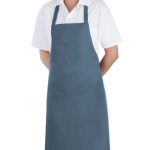 Back in the fourteenth century, the outer garment that cooks wore to shield their clothes from spatters and dribbles was called a napron. By the fifteenth century, however, the n at the beginning of the word had shifted over to the indefinite article that often preceded the word: that is, a napron became an apron (the same thing happened with the word umpire: it was originally numpire, but eventually its n also drifted away). Further back in history, the original napron was derived from the French name for this article of clothing, naperon, which in turn is a diminutive form of the French word nape, meaning tablecloth; both the old napron and the modern apron, therefore, literally mean little tablecloth. The French nape is also the source of the familiar napkin, and of the now defunct sanap, the name of a strip of fabric placed over the edge of an expensive table cloth to prevent it from being soiled. In French, the original form of sanap was sauve nape, literally meaning save the tablecloth; after adopting the word in the early fourteenth century, however, English shortened it to sanap, a form it retained until it became obsolete in the mid fifteenth century.
Back in the fourteenth century, the outer garment that cooks wore to shield their clothes from spatters and dribbles was called a napron. By the fifteenth century, however, the n at the beginning of the word had shifted over to the indefinite article that often preceded the word: that is, a napron became an apron (the same thing happened with the word umpire: it was originally numpire, but eventually its n also drifted away). Further back in history, the original napron was derived from the French name for this article of clothing, naperon, which in turn is a diminutive form of the French word nape, meaning tablecloth; both the old napron and the modern apron, therefore, literally mean little tablecloth. The French nape is also the source of the familiar napkin, and of the now defunct sanap, the name of a strip of fabric placed over the edge of an expensive table cloth to prevent it from being soiled. In French, the original form of sanap was sauve nape, literally meaning save the tablecloth; after adopting the word in the early fourteenth century, however, English shortened it to sanap, a form it retained until it became obsolete in the mid fifteenth century.
Outer garment covering the front of the body for protection of clothing during surgery or certain nursing procedures.
During fluoroscopy, the radiologists and the technologists are required to wear lead rubber aprons of 5mm lead equivalent.
